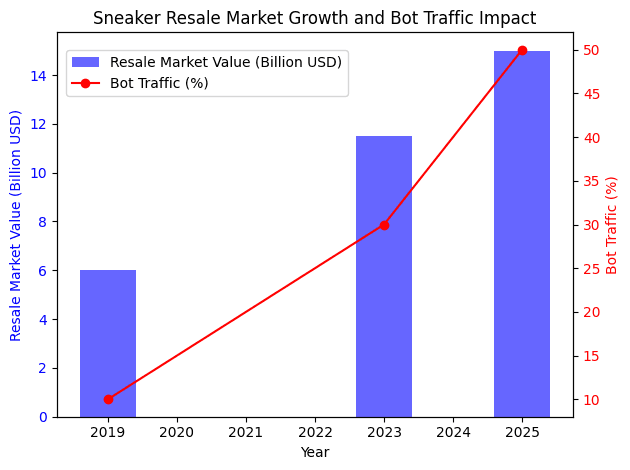Mar 24, 2025
The Double-Edged Sword of Sneaker Bots: How Automation is Shaping the Resale Market
Sneaker bots have become a defining feature of the sneaker resale market, simultaneously fueling its explosive growth and creating significant challenges for retailers and consumers. These automated tools, capable of purchasing hundreds of pairs in seconds, have reshaped the dynamics of sneaker drops, driving up resale prices while frustrating genuine buyers. With the sneaker resale market projected to reach $30 billion by 2030, bots are both a boon and a bane to this lucrative industry. Here's a deep dive into how bots are impacting the sneaker market, supported by data visualization and insights from industry leaders.
Sneaker Bots: A Force for Growth
Fueling Resale Market Expansion
Sneaker bots have played a pivotal role in driving the growth of the resale market by enabling resellers to secure large quantities of limited-edition sneakers. These bots automate tasks like adding items to carts and completing purchases faster than any human could, creating artificial scarcity that inflates prices on secondary markets like StockX and GOAT.
Lucy Rouse, Vice President of Nike's SNKRS app, revealed that "on any highly sought-after sneaker launch Nike executes, up to 50% of purchase entries can be bots." This level of bot activity has turned sneakers into an asset class akin to stocks or cryptocurrency.
Boosting Accessibility for Resellers
For resellers, bots lower the barrier to entry by reducing the time commitment required to secure sneakers. Automation allows even novice resellers to compete in the high-stakes world of sneaker drops. According to BlockApps, bots have enabled resellers to tap into a global resale ecosystem worth $10 billion in 2021 and growing rapidly.
The Negative Impact on Retailers and Consumers
Unfair Customer Experience
Bots often dominate sneaker releases, leaving genuine customers unable to purchase highly coveted products. Limited-edition sneakers sell out in seconds, forcing frustrated buyers to turn to secondary markets where prices are inflated.
A case study from Bodega, a Boston-based streetwear shop, highlighted this issue during a 2019 drop where 60% of sales went to bots. One user managed to secure hundreds of pairs while many loyal customers walked away empty-handed.
Distortion of Market Dynamics
Bots skew supply-and-demand dynamics by creating artificial scarcity. This drives up resale prices but undermines retailers' ability to gauge actual consumer interest. For example, during the Adidas Yeezy Boost 350 V2 "Zebra" release, overwhelming bot traffic caused Adidas' website to crash within minutes, disrupting sales and frustrating genuine buyers.
Damage to Brand Loyalty
Retailers like Nike and Adidas face backlash from loyal customers who feel alienated by bot-dominated releases. This erosion of trust can harm brand loyalty over time, especially as frustrated buyers turn away from direct purchases in favor of resale platforms.
Resale Market Growth vs Bot Traffic
The chart below illustrates the correlation between the growth of the sneaker resale market and the increasing prevalence of bot traffic:

Sneaker Resale Market Growth and Bot Traffic Impact 2019-2025

Sneaker Resale Market Growth vs Bot Traffic Impact (2019–2025)
Retailers Fighting Back Against Bots
Anti-Bot Measures
Retailers are investing heavily in anti-bot technologies like AI-enabled detection systems that analyze user behavior metrics (e.g., mouse movements, session duration) to identify bot activity. However, these measures are costly and not always effective.
Nike's SNKRS app has implemented stricter purchasing limits and CAPTCHA systems but still reports that up to half of entries are bots during major releases.
Legislation Against Bots
Governments are stepping in with anti-scalping laws like the Stop Grinch Bots Act proposed in the U.S. Senate. This legislation aims to prevent bots from bypassing purchasing limits or inventory controls on e-commerce platforms.
Exploring Direct-to-Resale Models
Some retailers are considering integrating resale directly into their platforms. By facilitating secondary sales themselves, brands could cut out scalpers entirely while maintaining control over pricing and customer experience.
The Future of Sneaker Bots
As technology evolves, so do sneaker bots. Their increasing sophistication makes them harder for retailers to combat effectively. At the same time, rising costs for bot creation and maintenance may limit their accessibility, creating an upper limit for their widespread use.
Lucy Rouse predicts that while bots will remain an integral part of the sneaker ecosystem, brands will need innovative solutions to balance fairness with profitability: "The arms race between retailers and bot creators will continue shaping this industry."
Conclusion
Sneaker bots are both a blessing and a curse for the resale market. They fuel its explosive growth but create significant challenges for retailers and consumers alike. As brands invest in anti-bot measures and governments consider stricter regulations, the future of sneaker botting remains uncertain.
For resellers, bots offer undeniable advantages in securing inventory quickly—but at what cost? As frustration among consumers grows, brands must find ways to restore fairness while maintaining profitability in this fiercely competitive space.
The question remains: Can sneaker culture thrive in an era dominated by automation? Only time will tell.